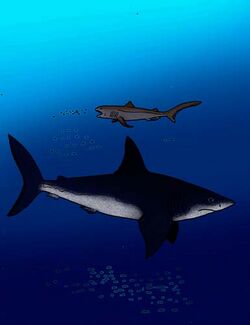Biology:Carcharocles auriculatus
| Carcharocles auriculatus | |
|---|---|

| |
| Teeth from Craven County, North Carolina | |
| Scientific classification | |
| Domain: | Eukaryota |
| Kingdom: | Animalia |
| Phylum: | Chordata |
| Class: | Chondrichthyes |
| Subclass: | Elasmobranchii |
| Subdivision: | Selachimorpha |
| Order: | Lamniformes |
| Family: | †Otodontidae |
| Genus: | †Carcharocles |
| Species: | †C. auriculatus
|
| Binomial name | |
| †Carcharocles auriculatus Blainville, 1818
| |
| Synonyms | |
| |
Carcharocles auriculatus[1] is an extinct species of large sharks in the genus Carcharocles of the family Otodontidae, closely related to the sharks of the genus Otodus, and also closely related to the later species megalodon. Its teeth were large, having coarse serrations on the cutting edge, and also with two large cusplets. The teeth can reach up to 130 millimetres (5.1 in), and belonged to a large "megatoothed" shark.
Assignment to the genus Carcharocles rather than Otodus
It is known that there is at least one genus in the family Otodontidae, that being Otodus. But the names and number of the genera in Otodontidae is controversial and the family's accepted phylogeny varies among paleontologists in different parts of the world. In the US and Britain the most widespread genus name for otodontids with serrated teeth is Carcharocles, and the owners of unserrated ones Otodus. In countries of the former USSR, like Ukraine or Russia , all of these genera were attributed to Otodus, because scientists like Zhelezko and Kozlov[2] thought that the absence or presence of tooth serrations is not enough to place these sharks in different taxa.
Size
The tooth length of C. auriculatus is relatively large - from 25 to 114 millimetres (0.98 to 4.49 in).[1] However, it is smaller than that of megalodon and Carcharocles angustidens; the tooth length of C. megalodon is 38 to 178 millimetres (1.5 to 7.0 in) and C. angustidens 25 to 117 millimetres (0.98 to 4.61 in).[1]
Distribution
Most C. auriculatus teeth come from South Carolina and North Carolina.[1] However, many Eocene shark teeth are known from Khouribga Plateau, in Morocco.[3]
Evolution
Carcharocles auriculatus is the second most primitive known member of the genus Carcharocles, second only to Carcharocles aksuaticus.[clarification needed]
Species
- Cretolamna appendiculata
↓
- Otodus obliquus
↓
↓
- Carcharocles auriculatus
↓
↓
↓
↓
Evolution of genera
The family of Otodontidae is well known and famous because of its last member - Megalodon. Yet, there were many other genera in this family, first appearing in the Cretaceous. The first one was Cretalamna,[4] one of the largest sharks in the Cretaceous. The teeth basal morphology was similar to the teeth of later Otodus. First, the crown was triangular. This feature helped the shark to bite harder, and this is the feature to which the otodontid evolution was leading for.[5] Second, there was a small protuberance on the labial side of the crown, which is also present in many other species of the family. But there was a feature, which limited the bite force, decreasing the area of the bite, the cusplets. The completely similar absolutely triangular unserrated (all the teeth of Cretalamna had no serrations, the cutting edge was smooth) cusplets were present in a later Otodus obliquus from Paleocene and Eocene. Otodus obliquus is the first large form of otodontid. The maximum size of the teeth was up to 100 millimetres (3.9 in).
References
- ↑ 1.0 1.1 1.2 1.3 1.4 Joe Cocke (2001). Fossil Shark Teeth of the World.
- ↑ Zhelezko, Kozlov (1999). Elasmobranch and biostratigraphy of Trans-Urals and Central Asia.
- ↑ Fossil Teeth. http://nutzstore.com/info/Shark%20Teeth%20ID.pdf. Retrieved 2011-07-18.
- ↑ K.Shimada (2007). "Skeletal and dental anatomy of lamniform shark, Cretalamna appendiculata, from Upper Cretaceous Niobrara Chalk of Kansas".
- ↑ L.S. Glickman (1980). Evolution of Cenozoic and Cretaceous lamnoid sharks [Russian].
Wikidata ☰ Q5038153 entry


